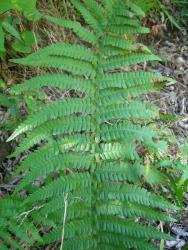Terrestrial ferns, evergreen or marcescent. Rhizomes erect or short-creeping (NZ) or rarely long-creeping (not NZ), scaly. Rhizome scales non-clathrate, ovate to narrowly ovate, margins entire, attached at base, concolorous, light brown to red-brown. Fronds monomorphic, not bulbiferous. Stipes and rachises scaly, adaxially sulcate. Laminae 1-pinnate to 3-pinnate-pinnatifid (NZ), or 4-pinnnate (not NZ), herbaceous, scaly. Veins free. Sori round, borne on abaxial surface, away from the margin, in 1 row either side of midrib; indusia reniform, peltate. Spores monolete; perispores rugose, tuberculate or cristate, sometimes minutely echinate on the surface.
A genus of c. 400 species, included in subfamily Dryopteridoideae (PPG 1 2016).
Dryopteris is considered to be monophyletic and sister to Arachniodes, and these two genera are in turn sister to the polystichoid ferns (Liu et al. 2016). Four subgenera with a total of 17 sections were recognised by Fraser-Jenkins (1986).
In NZ the genus is represented only by naturalised or casual species; none are indigenous. Three naturalised species, Dryopteris affinis, D. dilatata and D. filix-mas, were recorded by Brownsey (1981). Two casual species, D. cycadina and D. inaequalis, were reported by Heenan et al. (2004), another five, D. carthusiana, D. erythrosora, D. kinkiensis, D. sieboldii and D. stewartii, by Heenan et al. (2008), and two, D. formosana and D. wallichiana, by Ogle et al. (2021). D. cycadina is now regarded as fully naturalised.
| 1 | Laminae 1-pinnate | 2 |
| Laminae 1-pinnate-pinnatifid or more divided | 3 | |
| 2 | Primary pinnae in 1–4 pairs; pinna margins entire or minutely serrate; sori in 3–4 irregular rows either side of costa | sieboldii |
| Primary pinnae in 17–20 pairs; pinna margins deeply toothed; sori in 1–2 rows either side of costa | cycadina | |
| 3 | Laminae 2-pinnate-pinnatifid or more divided | 4 |
| Laminae 1-pinnate-pinnatifid to 2-pinnate | 7 | |
| 4 | Laminae 3-pinnate to 3-pinnate pinnatifid, ovate to pentagonal | 5 |
| Laminae 2-pinnate-pinnatifid to 3-pinnate, elliptic to ovate | 6 | |
| 5 | Basal basiscopic secondary pinna on the basal primary pinnae much longer than the acroscopic; scales on abaxial costae weakly inflated | formosana |
| Basal basiscopic secondary pinna on the basal primary pinnae only a little longer than the acroscopic; scales on abaxial costae minute and flat | inaequalis | |
| 6 | Rhizomes prostrate; rhizome scales pale brown, lacking a dark central area; fronds erect; laminae often parallel-sided in proximal half | carthusiana |
| Rhizomes erect; rhizome scales dark brown, often with a darker central area; fronds arching; laminae ovate | dilatata | |
| 7 | Fronds red-tinged when young; indusia with red centres | erythrosora |
| Fronds not red-tinged; indusia lacking red centres | 8 | |
| 8 | Secondary segments on lowermost primary pinnae stalked or sessile | 9 |
| Secondary segments on lowermost primary pinnae adnate to costae | 10 | |
| 9 | Scales on abaxial costae flat | stewartii |
| Scales on abaxial costae inflated at their bases | kinkiensis | |
| 10 | Stipe scales linear with long hair-points | wallichiana |
| Stipe scales ovate or narrowly ovate with short apices | 11 | |
| 11 | Rhizome and stipe scales golden brown; abaxial costae darkened at junction with rachis when fresh; secondary pinnae truncate; indusia inrolled when young | affinis |
| Rhizome and stipe scales pale brown; abaxial costae not darkened at junction with rachis when fresh; secondary pinnae rounded or obtuse; indusia flat when young | filix-mas |
In New Zealand all species of Dryopteris are naturalised and have fronds that are sometimes marcescent rather than evergreen. They are recognised by their terrestrial habit, erect or short-creeping rhizomes, 1-pinnate to 3-pinnate-pinnatifid, scaly fronds, and round sori protected by reniform indusia. The spores are rugose, sometimes with minute papillae on the surface (Large & Braggins 1991).
Dryopteris is primarily a genus of the northern temperate regions of Europe and North America, extending to warm temperate parts of central and eastern Asia, montane and southern Africa, Australia and the Pacific. It also occurs in tropical montane regions of Africa and south-east Asia, as well as in the Neotropics. The centre of diversity is in south-west China and the eastern Himalaya (Fraser-Jenkins 1986; Kramer 1990); 167 species in China (Wu et al. 2013); 38 species in Africa and Madagascar (Roux 2009), three in Australia (Field 2020), perhaps 12 in the south Pacific, and 10 in Hawai‘i (Palmer 2003); four naturalised and eight casual species in New Zealand; none indigenous.
| Category | Number |
|---|---|
| Exotic: Fully Naturalised | 4 |
| Exotic: Casual | 8 |
| Total | 12 |
The base chromosome number in Dryopteris is x = 41 (Kramer 1990). There is a polyploid series including diploid, triploid and tetraploid species, several of which are known to be apomictic (Lovis 1977).




